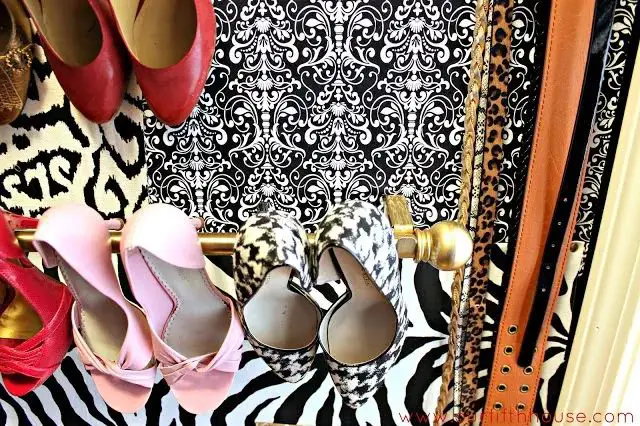Page Contents
Quick Answer
Yes, you can use a drapery rod as a closet rod in many cases. Drapery rods and closet rods have some similarities in how they are constructed and installed that allow a drapery rod to functionally work as a closet rod in certain situations. However, there are also some key differences that may make a drapery rod less than ideal for regular use as a closet rod.
Differences Between Drapery Rods and Closet Rods
While drapery rods and closet rods serve similar purposes in hanging items from horizontal supports, there are some notable differences:
Weight Capacity
Drapery rods are typically designed to hold lighter curtain panels, not the weight of clothes on hangers. The average drapery rod can hold 10-20 pounds. Closet rods can usually hold 50 pounds or more.
Installation Method
Drapery rods use smaller hardware brackets anchored to the wall. Closet rods have sturdier end supports attached to the wall or cabinetry.
Diameter
Drapery rods tend to be thinner, often 5/8 inch diameter. Closet rods are usually thicker, around 1 to 1 1/4 inches in diameter.
Length
Drapery rods come in limited sizes under 120 inches long. Closet rods can be custom cut longer to fit any closet width.
Finishes
Drapery rods come in simpler finishes like white, black, bronze, and nickel. Closet rods offer those options plus stainless steel, hardwood, and custom finishes.
Considerations for Using a Drapery Rod for a Closet Rod
Here are some things to keep in mind if substituting a drapery rod for a closet rod:
Weight Load
Only light clothing like shirts, pants, and dresses should be hung from a drapery rod. Heavier coats, dense fabrics, and full garment bags can overload the rod’s capacity.
Hanging Method
Use lighter plastic or wood hangers rather than heavy wire hangers. And spread clothes out over the length of the rod to distribute weight evenly.
Rod Support
Reinforce mounting brackets with screws into wall studs for optimal support. For extra long drapery rods, add a center support bracket.
Diameter and Length
Wider rods hold clothes better. Extend rods fully from side-to-side to maximize hanging space.
Finishes
Polished finishes like nickel and bronze work well for clothing. Stay away from unfinished rods.
Advantages of Using a Drapery Rod for a Closet Rod
Here are some potential benefits of using a drapery rod instead of a traditional closet rod:
Cost Savings
Drapery rods are typically less expensive than closet-specific rods. You can create a clothing rod at a fraction of the cost.
Quick Solution
Readily available drapery rods can be installed as a quick fix when you need an emergency closet rod. No need to wait for shipping.
Lightweight Clothing Option
It creates a place to hang lighter garments that don’t require a sturdy rod. Great for shirts, dresses, jackets, and delicate items.
Temporary Rod
Easily installed drapery rods work well as temporary closet rods during renovations or in rental units when you don’t want a permanent rod.
Finishing Touch
The stylish metals and custom finishes of drapery rods can add a decorative touch to a closet space as an accent rod.
Disadvantages of Using a Drapery Rod for a Closet Rod
Here are some of the possible drawbacks of using a drapery rod instead of a standard closet rod:
Weight Restrictions
Heavier items like coats, dense fabrics, and bulky storage totes may be too heavy for a lightweight drapery rod.
Insufficient Support
Without proper reinforcement and weight distribution along its length, a drapery rod installed as a closet rod can start to sag over time.
Limited Size Options
Finding an extra long drapery rod over 120 inches to fit a wide closet space can be difficult and may require splicing rods together.
Fewer Hanging Options
Drapery brackets do not always accommodate closet rod accessories like shelving, cabinets, and tie racks for scarves or belts.
Incompatible Hardware
Some slide-in closet organizing systems depend on specific closet rod diameters and brackets that drapery rods may not work with.
Best Practices
To maximize success using a drapery rod as a closet rod:
Rod Type
Look for a steel or heavy duty drapery rod with a weight capacity over 20 pounds. Wood rods are prone to sagging.
Rod Length
Measure the closet space and get the longest available drapery rod to minimize sagging issues.
Rod Diameter
Wider diameter rods (5/8 inch or larger) hold more weight than thinner rods.
Bracket Hardware
Reinforce mounting brackets by installing into wall studs if possible.
Weight Distribution
Spread lighter clothing items evenly across the rod. Group heavier items in center.
Maintenance
Check hardware connections regularly. Tighten or replace components if the rod starts to sag or loosen.
Closet Rod Alternatives
If a drapery rod doesn’t work well as a closet rod, some other household items can serve as temporary clothing rods:
Shower Curtain Rods
Sturdy spring shower rods or fixed shower rods with center support can often substitute for lightweight closet rods.
Shelving Standards and Brackets
Standards cut to length with shelf brackets installed perpendicular to the wall can support lighter clothing.
PVC Pipe
1 inch to 1 1/4 inch PVC pipes cut to length and anchored with pipe flanges can temporarily function as DIY closet rods.
Conduit
EMT conduit installed with conduit straps works similarly to PVC pipe for temporary closet rods.
Conclusion
While drapery rods are not ideal for heavy duty use as closet rods, they can serve well as temporary oraccent rods to hang lighter clothing items in a pinch. Follow best practices for hardware installation, weight limits, and rod maintenance to get the best results. Consider alternatives like shower rods or DIY PVC and conduit rods for other lightweight closet rod options. With some creativity and careful planning, drapery rods can pull double duty to increase your closet hanging space.
